Winchester-Nabu Detective Agency Year Three: Case File No. 32-136
AMBER LOVE 23-DEC-2019 Find out how all this began. Catch up on Year One and previous Year Two cases at the Winchester-Nabu Detective Agency. We are in YEAR THREE!
This work is supported by the generous backers who adore my cat stories at Patreon.com/amberunmasked and they also get first access to what’s happening with my books and podcast. For a one-time tip, you can go to the new PayPal.me.
‘Tis the Season of Unbridled Capitalism:
I’m an Amazon Influencer (I know, everyone is…) so you can shop through my personal recommendations on cat things, writing guides, books, and wellness supplies. Sometimes I offer my books for FREE on Kindle. You can follow my author page and get notifications; or follow me on Twitter and see if I announce any events like that. BOOKS MAKE GREAT GIFTS!
Where We Left Off:
Oliver Winchester and Guster Nabu captured a long-time squatter inside the main residence of the estate. The subject was released on his own recognizance into the wild.
Legacy in the Bones:
Thanksgiving Weekend (or Mourning Day) was still pleasant enough at the end of November for us to have outdoor patrols. In fact, Gus had a better than average hike on one of those days. We went all through the woods and he climbed many trees. It felt good to see him being his nature-loving self again like last winter.
Gus and I ended up on the north trail into the Woodland neighborhood. It’s one of the regular spots where I like to leave peanuts for the critters because there are a couple of other paths and trails that intersect it. There’s also a cute little spot Gus has carved out on his own for a shortcut to pass through. It has some bushes and a tree where he stalks birds. That shortcut isn’t great for humans. I trim it back enough so I can get through without getting caught too many times by the thorns, but it’s still a tight squeeze. There’s also a bush with a long curling base that I have to climb over. But next to that interesting thick vine cluster is a rock where Gus likes to rest.
On one of these walks, Gus went through this shortcut. I wasn’t going to follow him, but decided it could use a trimming so I changed my mind. I had to crouch down and that’s when something caught my eye. This is why I prefer winter hiking. There’s a way that the environment reveals itself from the Green Man’s leafy mask. A length of white was visible, but what? A lot of the dying leaves and branches cast a grey or ivory-white vibration. I was expecting a stick. Instead, I found a hollow long bone that had been scraped clean. The indented marks of teeth were obvious.
I didn’t want to try to identify the bone until after it was cleaned thoroughly. I slipped it into the empty peanut can, which is really an empty coffee can, and caught up to Gus to tell him I saw the clue he led me to. He was relieved I didn’t miss it.
I’ve no idea how long it takes for wildlife to pick a bone clean. This one was found right on top of a rock. I had to wonder then if it had been deposited there recently. It seems unlikely that I would have missed it last year when Gus and I kept finding bones all over the estate property and neighboring grounds. Our first find was in 2017, a short segment with a diameter of two inches. How did I miss it? Does it belong to the same set as the other bones? Is it new? The previous bones all belonged to a Jersey devil-deer hybrid or so we thought. The remains had been spread all over by the scavengers.
Bone Type Identification:
We had to identify the species of the bone to determine if it even matched the previous set. Oliver logged into the database and we scoured through long bones of mammals from this geographic area. We have been collecting our own samples of the not-so-mundane animals too. The magings don’t have a fancy internet database. We have to compare to the animals with the closest DNA makeup to any magings of this region.
Something I learned more from modeling at Kubert School than from studying anatomy, is that the femur (thigh bone) has a slight anterior curve to it (Thanks, Joel Tidey!). It’s something artists have to bear in mind and is a common mistake for people who haven’t studied anatomy that thoroughly. In the olden days, instructions for drawing made all the limbs perfectly straight stick figure type lines connected by circles to represent the joints. Even that doesn’t make sense since not all joints have circular motion; only ball and socket joints do like the femur to the pelvis and the shoulders. With this knowledge about the anterior curve of the femur, I deduced that the long bone segment was likely that.
Another thing is that the femur is the biggest bone in the mammal body. Our specimen is approximately one-inch in diameter. It’s definitely larger than the other long bone specimens in our possession. It could be consistent with the size of that skeleton.
There aren’t any heads left on the bone otherwise that would make identification much easier. There are spongy bone cells at both ends, one more than the other. These spongy cells would have contained red bone marrow. I accidentally broke off a chunk during the initial cleaning, but glued it back into place after all the cleaning was completed. This bone is about seven inches long.
Bone Cleaning:
The first stage of cleaning is a simple soap and water scrub using an old toothbrush and other cleaning brushes. I’ve been using Dawn dish soap which was recommended for its powerful grease-fighting ability. Some bones contain a lot of grease, especially if they are found with any meat on them.
The second stage is to soak the bone in a lidded container in water with the same soap. I left this one for two days, then changed the water and soaked for another round.
The third stage was to soak in water and hydrogen peroxide. I used approximately a 2:1 ratio. That day happened to be one where our well water was disgusting and quite brown coming out of the tap. As soon as the filter for the house was changed, I dumped out that container and refilled it with clean water and peroxide. After a few days, I removed the bone and set it aside to dry. Once dry, it became a much brighter shade of white but still in the more ivory side of the spectrum. It looks great and the details of the teeth marks are clear.
In the collection of the previous set of bones that Gus and I found over the course of 2018, there hadn’t been a femur. We were torn between automatically assuming this one belonged to that set versus wondering why it would suddenly appear when and where it did. Now that we’ve compared the diameter, it was still unclear whether this bone came from the same creature or an even larger one so we continued on with the research. In fact, it made me question the previous finds.
Correcting Previous Cases:
Since the first bone found had a considerably wider diameter, I thought that could have been a bigger bone of that Jersey devil-deer. I filed all of them together. But now that we have this obvious long bone with an anterior curve, we have to revisit that original case from 2017. There were two bone specimens discussed in Year One Case No. 51. Both of those had wider diameters than this Thanksgiving discovery. Those two specimens were more the size of a horse or bear!
In 2018, the Pennsylvania Game Commission launched a research study through Penn State University including a directive to treat black bears with mange, a contagious parasitic disease. Their goal was to affix tracking collars to 24 bears with moderate cases of mange and treat half of those with Ivermectin. Another 12 bears determined to be healthy would be tracked also for comparison.
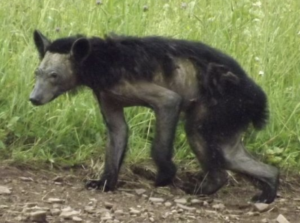
As we discussed in another recent November 2019 case, what the average person identifies as a bear may have more in store. How many volkolaks have been misidentified as full-blooded black bears? We took a look at the photograph by the PA Game Commission of a bear with mange and it certainly looks like a bear creature in a “were-state” mid-transformation. If you can imagine a werewolf, for example, transforming this is the same, only a bear. For more information, although in a fictionalized account, read my novel Bear Roots.
Case Findings:
Oliver, Gus, and I believe we can close three cases with more confidence by having this one bone discovery from a few weeks ago.
The two shorter, wider bone segments belong to a volkolak, not a Jersey devil-deer nor a white-tailed deer as previously theorized. Those bones do not belong to the Jersey devil-deer skeleton of Y1C51.
The bulk of the bones from that case do belong together and are a Jersey devil-deer specimen.
The new bone discovered over Thanksgiving 2019 is a separate Jersey devil-deer specimen not belonging to the 2018 skeleton. It is unlikely the bone would have had any meat left on it for scavengers to have relocated it during feeding.
Case Status: Closed
Previous Cases Mentioned:

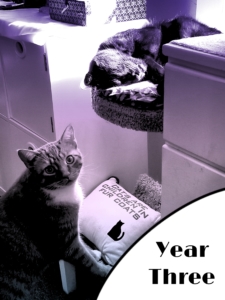
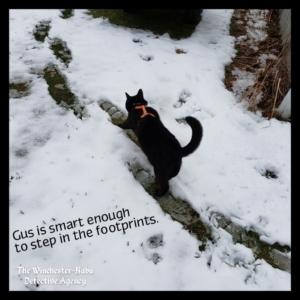
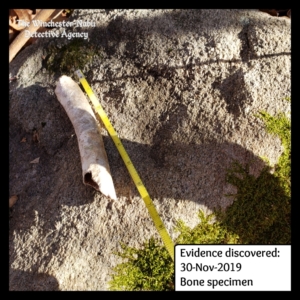
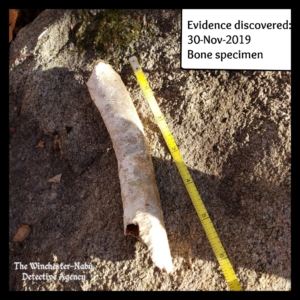
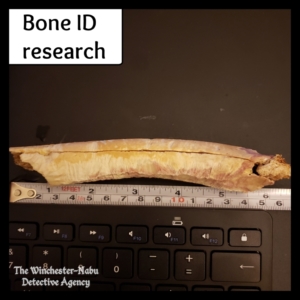
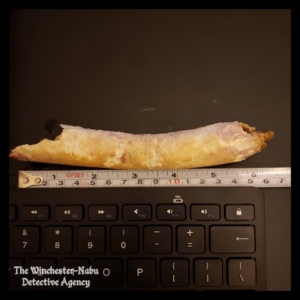
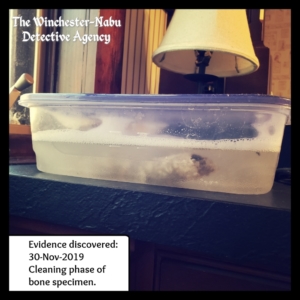
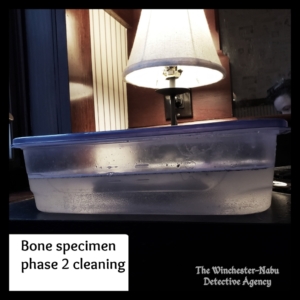
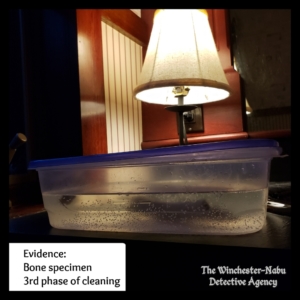

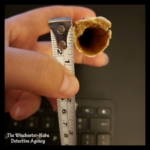
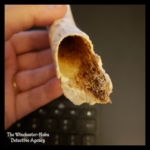
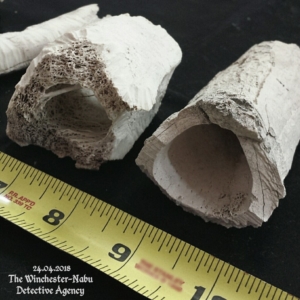
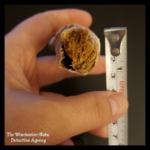
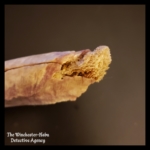
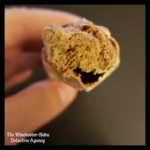
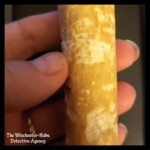
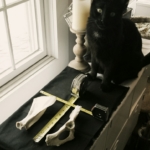
1 Comment on Winchester-Nabu Detective Agency Year Three: Case File No. 32-136
Comments are closed.